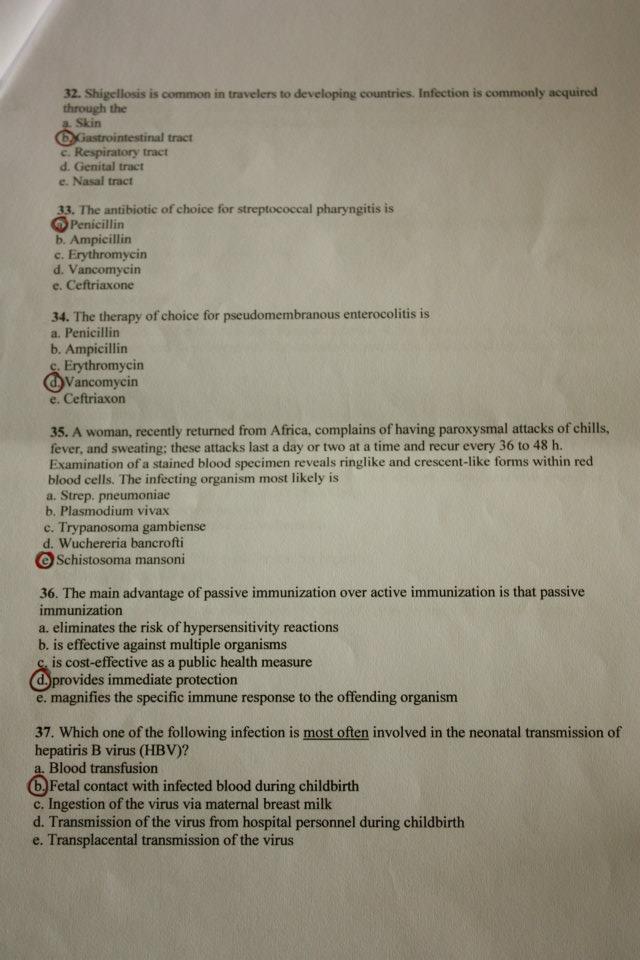600690D2092672488119s4535595 n

32. Shiycłiośs i* common in invtlcn to dc\ doping countrics Intcclion is commonty acquimi
chrough the a Skin
^^Ciaatrmnicstirul traci
c. Respiratory traci
d. (icnitaJ traci
c. Nasai traci
33. fhe antihiotic of choice for streptococcal pharyngitis is ^}Pcruciliin h. Ampicillin
c. Erythromycin
d. Vancomycin C. Ccftriaxonc
34. The therapy of choice for pseudomembranous enterocolitis is
a. Penicillin
b. Ampicillin
c. Erythromycin (J)Vancomycin
e. Ceftriaxon
35. A woman. rccently retumed firom Africa. complains of having paroxysmal attacks ofchills, fevcr. and sweating: thesc attacks last a day or two at a time and recur cvcry 36 to 48 h. Examination of a stained blood spccimcn reveals ringi ike and crescent-likc forma within red blood cells. The infecting organism most likely is
a. Strcp. pneumoniae
b. Plasmodium vivax
c. Trypanosoma gambiense
d. Wuchereria banerofti {e) Schistosoma mansoni
36. The main advantage of passive immunization over active immunization is that passive immunization
a. eliminates the risk of hypersensitivity reactions
b. is effective against multiple organisms
c. is cost-eflective as a public health measure \T)provides immediate protection
e. magnifies the specific immune response to the oflfending organism
37. Which one of the following infection is most often involved in the neonatal transmission of hepatiris B virus (HBV)? a. Blood transfusion
@Fetal contact with infectcd blood during childbirth
c. Ingestion of the virus via matemal breast milk
d. Transmission of the virus from hospital personnel during childbirth
e. Transplaccntal transmission of the virus
Wyszukiwarka
Podobne podstrony:
must be performed in order to implement a high performance hardware component that carries out the o
To sum up In my opinion Moreover especially On disadvantage is that finally On the other
42 SUKUMARI BI1ATTAC11ARJ1 Her Galava leni to four kings in tum, to eaeh of whom shc borę a son, Gfi
34405 reading READING - perceiving a written text in order to understand its contents. It is a compl
Eq. (12). In order to obtain J„, it is necessary just to run the program, and verify the open Circui
• ensuring that the person in charge of a unit, plant or installation is aware of
PIN diode probe schematic DC in DC in NOTEs Dl must be in total darkness. DC in O Up to 30V Gnd O 2p
05 (23) 32. A technician has been asked to install a second optical drive in a Com
img037 2 288 EMPLOYERS- UABIUTY duties in existence, to consider the common law alone would give a f
110 Zofia Kaczorowska In order to present the results of certain larger physiographic units linked b
P: Jak byliśmy pad Krakowem, to zmokliśmy do suchej nitki - mówi z uśmiechem. (SW 2005/32. 6) N: Ais
s&h 032 32 STTiENGTII AND HEALTH (lows to his head in an inercased cjnautity, and thc result i.s hea
ANEMONIES 1 edging EjB" (1 17 3/4“ 3-dc bobble dutter <Bcl> } = insuft hook in di to whic
więcej podobnych podstron